文章目录
引言
- 今天算法得是速通的,严格把控好时间,后面要准备去面试提前批了,项目得赶紧过!
- 今天复习一个模板,然后在整理一个模板!
新作
二分模板
cpp
void binSearch(int[] nums,int l,int r){
while(l<r){
int mid = (l + r + 1) >> 1;
if(nums[mid] >= tar) l = mid;
else r = mid - 1; 二分查找------搜索插入位置
复习实现
- 这里是使用左边界的
cpp
class Solution {
public int searchInsert(int[] nums, int tar) {
int l = 0,r = nums.length - 1;
while(l < r){
int mid = (l + r) >> 1;
if(nums[mid] > tar) r = mid;
else if(nums[mid] == tar) return mid;
else l = mid + 1;
}
if(nums[l] < tar) return l + 1;
return l ;
}
}
右边界
cpp
class Solution {
public int searchInsert(int[] nums, int tar) {
int l = 0,r = nums.length - 1;
while(l < r){
int mid = (l + r + 1) >> 1;
if(nums[mid] < tar) l = mid;
else if(nums[mid] == tar) return mid;
else r = mid - 1;
}
System.out.println(r);
if(nums[r] < tar) return l + 1;
return r ;
}
}
搜索二维矩阵
复习实现
- 这道题两种实现方式,一种是做两次二分查找,不过要明确好使用左边界还是右边界,是找第一个小的值还是第一个大的值,然后再确定是否存在,不存在直接跳出。这种比较耗时。
- 还有一种坐标转换,将所有的元素排成一个序列,然后从左到右进行查询,确定到具体的目标是转成对应二维矩阵的信息,进行比较!
cpp
class Solution {
public boolean searchMatrix(int[][] mat, int tar) {
// define the row and col of array
int m = mat.length;
int n = mat[0].length;
// binSearch on the conversion of the index
int l = 0;
int r = m * n - 1;
while(l < r){
int mid = (l + r) >> 1;
if(mat[mid / n][ mid % n] >= tar) r = mid;
else l = mid + 1;
}
return mat[l / n][ l % n] == tar;
}
}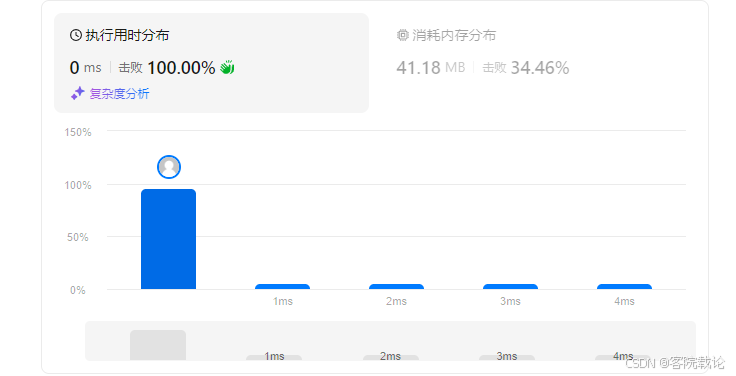
我靠,这样写,出奇的顺利,差不多五分钟就写完了!
新作
反转链表
个人实现
- 这个就是常规的反转链表,很常见!
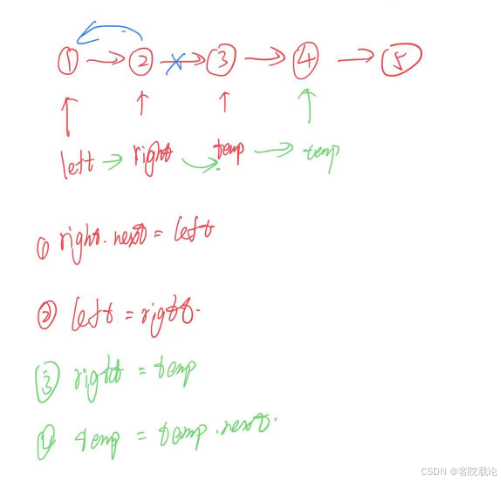
cpp
/**
* Definition for singly-linked list.
* public class ListNode {
* int val;
* ListNode next;
* ListNode() {}
* ListNode(int val) { this.val = val; }
* ListNode(int val, ListNode next) { this.val = val; this.next = next; }
* }
*/
class Solution {
public ListNode reverseList(ListNode head) {
// handle the edge situation
if(head == null || head.next == null) return head;
// define dummy head to store the head node
ListNode dummy = new ListNode();
dummy.next = head;
// reverse the node list
ListNode left = dummy.next;
ListNode right = left.next;
ListNode temp = right.next;
left.next = null;
while(temp != null){
right.next = left;
left = right;
right = temp;
temp = temp.next;
}
right.next = left;
left = right;
dummy.next = right;
return dummy.next;
}
}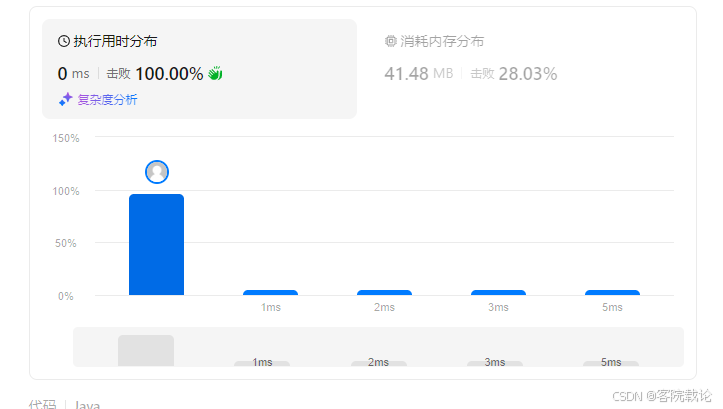
写是写出来了,但是太散了,还是要参考一下啊
参考实现
cpp
/**
* Definition for singly-linked list.
* public class ListNode {
* int val;
* ListNode next;
* ListNode() {}
* ListNode(int val) { this.val = val; }
* ListNode(int val, ListNode next) { this.val = val; this.next = next; }
* }
*/
class Solution {
public ListNode reverseList(ListNode head) {
// handle the edge situation
if(head == null || head.next == null) return head;
// define dummy head to store the head node
ListNode dummy = new ListNode();
dummy.next = head;
// reverse the node list
ListNode left = null;
ListNode right = dummy.next;;
while(right != null){
ListNode temp = right.next;
right.next = left;
left = right;
right = temp;
}
dummy.next = left;
return dummy.next;
}
}总结
- 其实我的代码有很多重复的地方,完全没有必要,总结下来:
- 反转链表两节点,next和pre,临时保存用temp,最终返回是pre。
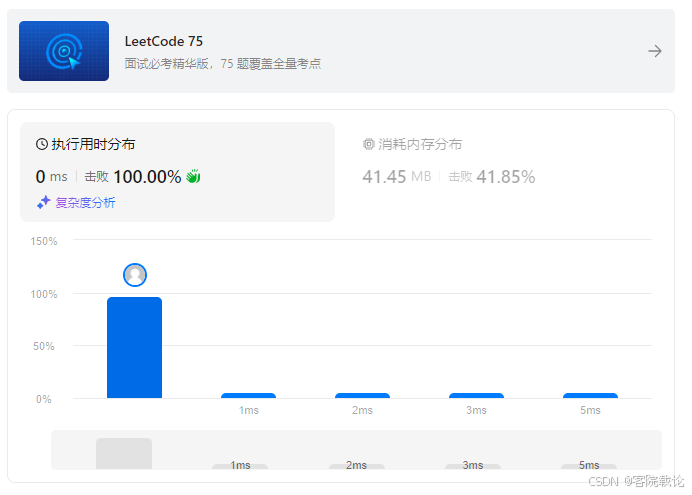
回文链表

注意
- 链表节点数最少为1,直接返回
- 链表的值不用担心越界
- 要求时间复杂度是O(n),空间复杂度是O(1)
个人实现
- 这个是回文链表,也就双指针可以做,因为空间复杂度是O(1),并没有办法使用其他的数据结构,所以想想看,双指针怎么遍历。
- 如果节点数是奇数,一定不会是回文字符串,直接返回false
- 如果节点数是偶数,那么就要找到中间的节点数,直接将字符串进行拼接,然后再用反转不就行了!
- 遍历一遍,保存为字符串,先判定数量,数量一致,在使用字符串的操作。
- 看错了,回文是从前往后读,和从后往前读是一致的!
cpp
/**
* Definition for singly-linked list.
* public class ListNode {
* int val;
* ListNode next;
* ListNode() {}
* ListNode(int val) { this.val = val; }
* ListNode(int val, ListNode next) { this.val = val; this.next = next; }
* }
*/
class Solution {
public boolean isPalindrome(ListNode head) {
ListNode temp = head;
StringBuilder str = new StringBuilder("");
// traverse the list and judge the length
while(temp != null){
str.append("" + temp.val);
temp = temp.next;
}
String substr1 = str.toString();
//System.out.println(substr1 );
String substr2 = str.reverse().toString();
//System.out.println(substr2 );
return substr1.equals(substr2);
}
}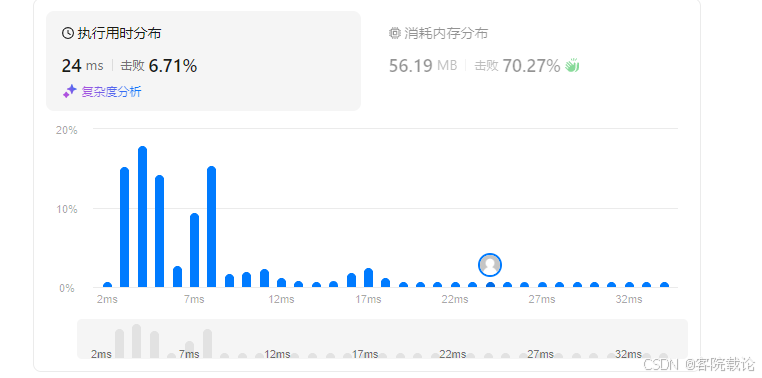
问题
将int转成String
- String.valueOf(4);
- Integer.toString(4);
- "" + 4
StringBuilder的相关操作
- 添加元素:append,可以添加char,int还有string
- 删除元素:delete(start_idx,end_idx),删除这段索引之间的字符串
- 转为String:toString
- 获取子串:substring(start_idx,end_idx),注意,一定要是小写
- 获取长度:length(),除了collection是用size,其他都是使用length,不过string系列的要加括号
- 字符串比较相等,使用equals,不要使用==,需要转为string
- 字符串反转,reverse(),只能使用stringBuilder进行调用
这题做的不容易,补充了好多知识,真不容易!
参考实现
- 参考样例实现了三个方法
方法一
- 将数组保存为数组,然后的使用双指针进行反向遍历,跟我的很像。
方法二
- 使用栈实现逆序遍历,然后正向读取数据,然后的入栈,在逐个出栈,就是反向遍历单链表了。
方法三------快慢指针
- 两倍快指针到了终点,然后慢指针就是中点
- 反转两个链表,分别进行比较,然后再反转回来!
逆序遍历出栈入栈,确定中点快慢指针
和为K的子数组

注意
- 必须要连续的序列,并且不能为空
- 可以为1个,可能是两个
- k是目标值,不会越界
- 数组是没有任何顺序的
个人实现
- 数组没有任何顺序,所以不能使用两数之和的方式进行计算,这里得想办法,表示一下两者的关系。
- 这里没有对时间复杂度做出要求,所以我们可以尝试直接暴力搜索去做。
- 实现思路如下
- 将前i项的序列保存为字典,O(n)
- 遍历每一个索引,并在字典中找到对应的索引值,找到了就符合条件,找不到跳过。O(n*n),最坏是平方。
- S[k] - S[i] = k,i<k
cpp
class Solution {
public int subarraySum(int[] nums, int k) {
// res == result
int res = 0;
// define the array to store the value of the sum
int m = nums.length;
int[] sumN = new int[m];
sumN[0] = nums[0];
// handle the special situation
if(m == 1 && nums[0] != k) return 0;
Map<Integer,List<Integer>> map = new HashMap<>();
List<Integer> tempZero = new ArrayList<Integer>();
tempZero.add(0);
map.put(nums[0],tempZero);
if(nums[0] == k) res ++;
//System.out.println(map.get(nums[0]).toString());
for(int i = 1;i < m;i ++) {
sumN[i] = nums[i] + sumN[i - 1];
//System.out.println(sumN[i]);
List<Integer> temp = map.getOrDefault(sumN[i],new ArrayList<Integer>());
temp.add(i);
map.put(sumN[i],temp);
if(sumN[i] == k) res ++;
}
System.out.println(res);
// traverse the array to judge list
for(int r = 0;r < m;r ++){
int resTar = sumN[r] - k;
if(map.containsKey(resTar)){
for(int x : map.get(resTar)){
if(x < r) res ++;
}
}
}
return res;
}
}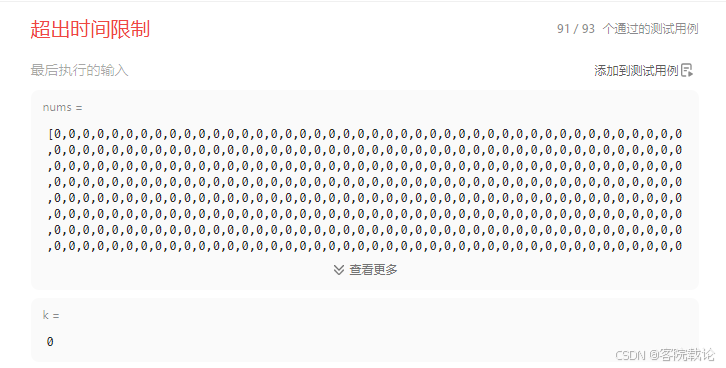
整了半个小时,就整出来这么几个东西,尴尬,超时了!
问题
Arrays.asList和ArrayList并不兼容,会出错
- Arrays.asList返回的是一个固定长度,然后ArrayList是返回一个不定长动态数组,这两个互不兼容,所以不能实现如下操作
cpp
List<Integer> temp = Arrays.asList(1);
temp.add(1)new ArrayList (0):并不会创建一个包含元素零的Arraylist,会出错!
- new ArrayList(x):是返回一个初始长度为x的列表,并不是返回一个有0的ArrayList,可以使用如下方式创建
- new ArrayList(Arrays.asList(1,2,3,0)):创建了包含四个元素的数组
参考实现
- 基本思路是一致的,但是我有一个地方没有考虑到,浪费了很多时间,具体如下。针对索引为i的目标而言,我只需要一个包含前i-1的前缀和序列就行,并不需要包含后续的,我添加的元素的过程不就是这样吗?但是我是先把所有的元素都添加完,然后再过滤的,这就是一个很大的问题!
- 边保存,边计算

cpp
class Solution {
public int subarraySum(int[] nums, int k) {
// res == result
int res = 0;
// define the array to store the value of the sum
int m = nums.length;
int[] sumN = new int[m];
sumN[0] = nums[0];
// handle the special situation
if(m == 1 && nums[0] != k) return 0;
Map<Integer,Integer> map = new HashMap<>();
//List<Integer> tempZero = new ArrayList<Integer>();
//tempZero.add(0);
map.put(nums[0],1);
if(nums[0] == k) res ++;
//System.out.println(map.get(nums[0]).toString());
for(int i = 1;i < m;i ++) {
sumN[i] = nums[i] + sumN[i - 1];
// judge fron 1 to i
int resTar = sumN[i] - k;
res += map.getOrDefault(resTar,0);
map.put(sumN[i],map.getOrDefault(sumN[i],0) + 1);
if(sumN[i] == k) res ++;
}
return res;
}
}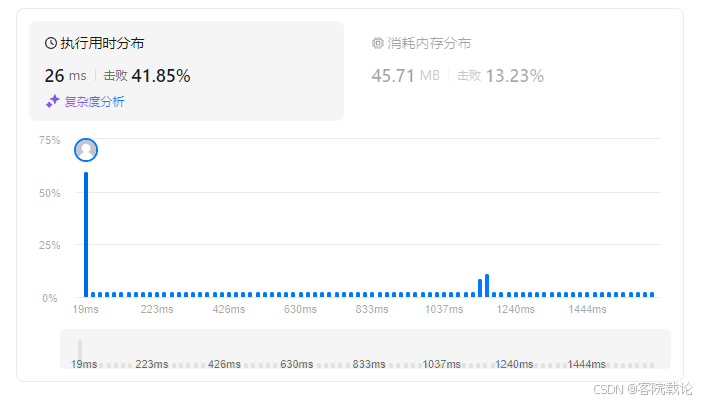
这就过了,关键是怎么记忆?
字串和哈希,边算边添加
总结
- 老是会把问题想复杂,然后明明能做出来的,但是会超时,不应该这样的!
- 又做了那么久的算法,下午还得补专利,估计没啥时间弄项目了,不行呀!
- 又是一个深夜,今天晚上去看电影了,过了一遍百度的一个面经,然后做了几道算道题,有投了两家公司,但是专利还是没有写,明天上午先写专利,在做项目,然后的再刷算法!
